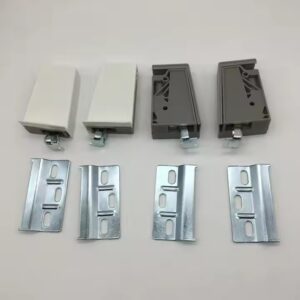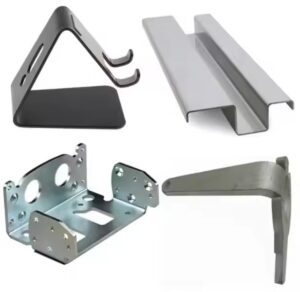Hi everyone, Vincent here! Running a metal fabrication shop for over a decade has taught me one important thing—metal might not always be visible in home appliances, but it’s the backbone of their functionality. From the compressor in your refrigerator to the heating elements in your oven, metal components are everywhere, ensuring durability, safety, and efficiency. Today, I’ll walk you through some key examples of how metal parts are used in the home appliance world and why they are so critical.
1. Refrigerators: The Hidden Metal Heroes
While much of your refrigerator’s interior—like the shelves and drawers—is made of plastic, the critical components that make it run are all metal.
Key Metal Applications:
- Compressor Housings:
The compressor is the heart of the fridge, and its housing is typically made of steel. This metal casing protects the moving parts inside from vibration, moisture, and debris while ensuring the system operates quietly and efficiently. - Evaporator and Condenser Coils:
These coils, often made of copper or aluminum, are crucial for the cooling process. Copper is excellent for thermal conductivity, while aluminum offers a more lightweight, cost-effective alternative. - Door Hinges and Handles:
Stainless steel is commonly used for durable door hinges and handles, especially in higher-end models. These components must endure constant use without loosening or breaking.
2. Ovens and Stovetops: Built to Handle the Heat
When it comes to cooking appliances, metal is essential because of its ability to conduct heat and withstand high temperatures.
Key Metal Applications:
- Heating Elements:
The electric heating elements in ovens and stovetops are usually made of nickel-chromium (nichrome) wire. This material has high electrical resistance and can sustain repeated cycles of heating and cooling without degrading. - Oven Liners and Racks:
The interiors of ovens, including the liners and racks, are typically made from stainless steel or coated steel. These materials resist corrosion and are easy to clean, making them ideal for withstanding high heat and frequent use. - Gas Burners and Grates:
In gas stoves, the burners and grates are often made of cast iron or stainless steel. Cast iron retains heat well, while stainless steel offers a sleek look and corrosion resistance.

3. Washing Machines: Built for Tough Loads
Washing machines are true workhorses in any home, and metal plays a crucial role in ensuring they can handle heavy use.
Key Metal Applications:
- Drum Tubs:
High-quality washing machines use stainless steel drums for the inner tub. Stainless steel resists rust, maintains its shape during high-speed spins, and is gentle on clothes over time. - Springs and Shock Absorbers:
Metal springs and shock absorbers keep the washing machine stable during spin cycles. These components are typically made from high-strength steel to endure years of heavy loads and vibrations. - Motor and Gear Housings:
The motor that drives the washing machine needs a sturdy, heat-resistant housing, often made from steel or aluminum alloys. This ensures longevity and reliability under constant use.
4. Microwaves: Precision and Safety
Microwaves might look like simple boxes, but their functionality depends heavily on precisely engineered metal components.
Key Metal Applications:
- Magnetron Components:
The magnetron, the microwave’s core, includes components made from copper and aluminum, which ensure efficient thermal and electrical conductivity. - Interior Surfaces:
The microwave’s interior cavity is often lined with stainless steel or coated metal to reflect microwaves evenly, ensuring food heats consistently. - Outer Casings:
The microwave’s outer housing is typically made of steel, providing both durability and electromagnetic shielding for safety.
5. Vacuum Cleaners: Lightweight and Durable Metal Solutions
Vacuum cleaners rely on metal parts to balance strength and weight, ensuring portability without sacrificing durability.
Key Metal Applications:
- Motor Components:
The motor inside a vacuum cleaner includes precision-engineered metal parts like aluminum fans and steel shafts. These components are designed to handle friction, heat, and high-speed rotation. - Extension Wands and Attachments:
Many vacuum cleaners use lightweight aluminum or stainless steel for their extension wands. These metals are strong enough to resist bending while remaining easy to handle.
Why Metal is the Backbone of Home Appliances
So why is metal such a go-to material in the home appliance industry?
- Durability: Metal components can withstand years of daily use without breaking down.
- Heat and Corrosion Resistance: Appliances often operate in challenging environments—think heat in ovens or moisture in washing machines. Metals like stainless steel and aluminum excel in these conditions.
- Precision and Reliability: Metal parts can be machined to tight tolerances, ensuring they work seamlessly with other components.
Conclusion
When you think about home appliances, it’s easy to focus on the exteriors—sleek designs, shiny finishes, and user-friendly interfaces. But it’s the metal components behind the scenes that make everything run smoothly. From the compressor in your refrigerator to the heating elements in your oven, these parts are the real workhorses that ensure your appliances are safe, reliable, and long-lasting.
At our shop, we’ve had the privilege of working with appliance manufacturers to create everything from custom oven racks to precision motor housings. It’s satisfying to know that the components we produce are helping families cook meals, clean clothes, and keep their homes running smoothly.
If you’re in the appliance business and need high-quality, reliable metal components, feel free to reach out. We’d be happy to help bring your designs to life with parts that meet the highest standards.




